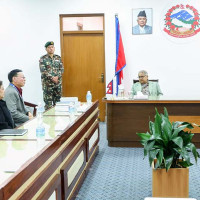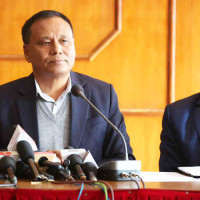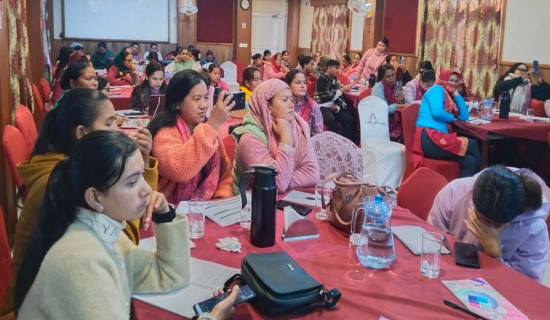- Thursday, 25 December 2025
Boost Investment In Productive Sectors For Growth
The GDP growth in the first quarter (Q1) of the current fiscal year (FY) failed to catch up with that in the previous Q1. The Q1 growth is estimated to be 3.4 per cent - lower than the previous 3.6 per cent. Nepal has already been facing a headwind to accelerate GDP growth despite multiple efforts through policy reforms and implementation of a host of plans. The real GDP grew by only 4 per cent annually during the last decade. The contraction in Q1's GDP has raised a doubt on whether the government aim of achieving 6 per cent growth this FY could be achieved.
In addition, the growth of the main drivers of economy like construction, accommodation and food services, finance and insurance and information and communication in the Q1 is weaker than they were in the previous FY. Also, credit growth rate has been very low as of the mid-term of the current FY. In the first six months, the domestic credit grew by 4.8 per cent - lower than 8.7 per cent of the previous FY. Meanwhile, private sector credit grew by 6.9 per cent which is slightly better than the previous 5.8 per cent. However, the government spending so far in the mid-term review is not so encouraging. Therefore, the aim of achieving 6 per cent growth seems challenging without aggressive mobilisation of investment in the second half.
Outflow of credit
In 2017, the capital expenditure increased by 70.6 per cent, recurrent expenditure by 39.8 per cent and private sector credit by 18 per cent when the GDP growth jumped 8.59 per cent. Afterwards, the private sector credit grew impressively from 2017-19. Specifically, bank and financial institutions (BFIs) credit towards primary and secondary sectors like agriculture, mine, production, construction, metal and machinery was significantly high.
Due to the massive private investment together with a significant rise in public spending the GDP growth intensified at an average of 7.45 per cent during these three FYs. Before slowing down, the private sector credit grew consistently at an average of 18 per cent from 2017 to 2022. It is also notable that the government capital expenditure increased 21 per cent and private credit grew 26.3 percent during a 4 percent V-Shape recovery of FY 2020/21.
The intense rise in the demand for loanable fund observed by the private sector over that period raised commercial bank lending interest rate, which reached 18-month high to 13 per cent in 2023 from 8.57 per cent in 2022. However, the outflow of credit started to slow down after FY 2022. Meanwhile, the government's steady spending helped economy grow in 2023 despite the feeble private sector credit growth.
However, the size of the government expenditure has been very low relative to its annual target. The recurrent expenditures - 42 percent - and capital expenditure -18 percent - in the mid-term review has illustrated how the government spending are being inadequately mobilised. Due to the sluggish credit growth, the interest rates have fallen and surplus liquidity has gone up. The interest rate of commercial banks dived three-year low to 8.69 per cent.
Also, there has been a significant rise in the inflow of remittance. Amid this situation, it is crucial that the fund be mobilised aggressively. Should this not happen, the target of economic growth remains unattainable.
However, the surging inflation has made it difficult to execute this. Towards the end of the mid-term it is already soaring above the NRB’s (Nepal Rastra Bank) set target of 5 per cent. Anchoring the inflation will remain a matter of concern while injecting liquidity. In addition, the slow government expenditure and credit mobilisation post-Covid-19 V-shape recovery despite the deepening cost of loanable fund necessitates a deep consideration. There is a need to boost the confidence in the private sector to unfreeze the surplus liquidity.
Aggressive investment
The impressive growth over 2017-22 was boosted mainly by secondary sector and a decent growth of primary sector. Specifically, a significant growth was witnessed in agriculture, mining and quarrying, manufacturing, electricity and construction. But the growth in mining, electricity and construction has been dismal in Q1. Making matters worse is shrinking credit mobilisation in agriculture and mining in current FY.
Meanwhile, the growth in agriculture and electricity remained encouraging in the last few years, with the former growing at an average of 3.2 per cent since 2016/17 and electricity and gas expanding at an average of 20 per cent in the last decade. Although there is a slight fall seen in aggregate credit mobilisation in agriculture and mining, lending by the private sector has been on upward trajectory, albeit slightly, as of mid-term. In an encouraging sign, the credit towards production and construction has relatively improved.
Meanwhile, achieving the 6 per cent annual growth requires a robust growth in the next three quarters. With the current 3.4 percent in the Q1, it is looking highly challenging. Despite challenges, mobilising investment towards primary and secondary sectors at a time when interest rate is low could accelerate economic growth. Specifically, an aggressive investment in agricultural, manufacturing, mining, road, electricity and construction is critical to make this happen.
(Chhetri is a finance reporter at The Rising Nepal.)





-square-thumb.jpg)
-original-thumb.jpg)










